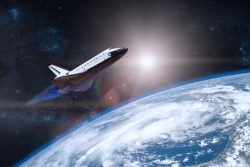 Zero gravity conditions found in space may be the secret to mass producing stem cells with life saving advances here on earth.
Zero gravity conditions found in space may be the secret to mass producing stem cells with life saving advances here on earth.
Stem cells tend to be more productive in microgravity conditions. They could be produced by biomanufacturing biomaterials like microbes and substances to be used in clinical, preclinical and therapeutic applications.
Researchers have found that microgravity and spaceflight are desirable places for biomanufacturing. This is due to the fact that a variety of special properties can be sent to biological processes and tissues. This may help produce cells and other products in a method that can’t be done on earth.
The last 10 years have shown exceptional progress in regenerative medicine research in space technologies which are creating new avenues to commercialize and access space.
More than fifty possible business opportunities for conducting biomanufacturing could be available in space. The three most promising were biofabrication, disease modeling, and products derived from stem cells.
Biofabrication uses manufacturing processes in order to produce materials like organs and tissues. Printing in the form of 3D is one of the basic biofabrication technologies.
A significant issue with the production of these materials on earth involve gravity-induced density. This makes it difficult for cells to expand and grow. With the absence of density of gravity in space, researchers hope they can use printing in the form of 3D to print unique products and shapes in a manner that can’t be done of earth.
Disease modeling is used to study diseases and potential treatments by copying full function structures using organoids, stem cells or other tissues.
Researchers have discovered that exposing the body to low gravity conditions for an extensive period of time can accelerate aging and bone loss. Through the development of disease models, researchers are able to understand the mechanisms of disease progression and aging,
This work not only helps astronauts, but can lead to manufacturing skeletal muscle or bone constructs. These can then be used for diseases such as osteoporosis and similar varieties of muscle wasting in the acceleration of bone aging that happen on earth.
The third avenue is stem cell production in relation to understanding how their fundamental components are affected by microgravity. It is important to discover some of the properties that lead to stem cell renewal and differentiation.
Through understanding how stem cells are affected in spaceflight it can possibly lead to improved manufacturing of stem cells in low gravity. Plans are in process with NASA and a private contractor to send stem cells into space next year. This will determine whether it is possible to produce them in large quantities in an environment that is low gravity.
To view the original scientific study click below:
Biomanufacturing in low Earth orbit for regenerative medicine





